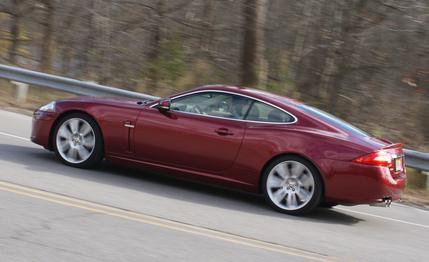 Short Take Road Test
Short Take Road Test

The XKR is the most-performance-oriented model in Jaguar’s current lineup, so it’s appropriate that the storied English automaker upped the ante for 2010 by fitting a 510-hp, 5.0-liter supercharged V-8 in place of the old model’s 420-hp, 4.2-liter supercharged unit. (The base XK gets a 385-hp, 5.0-liter naturally aspirated V-8 instead of the previous car’s 300-hp, 4.2-liter V-8.)
But that wasn’t the only change for 2010. The XKR gets revised exterior styling with a more aggressive front bumper, LED rear lights, and a different lower rear spoiler. Chrome now adorns the window surrounds, and the side vents are body color. When equipped with the optional 20-inch wheels, the XKR is a real beauty that looks almost as elegant as an Aston Martin DB9.
Fully Loaded
Inside, the changes aren’t all so welcome. The XKR gets more luxurious leather door trim and a revised steering wheel with a leather-wrapped lower spoke. But it also receives the so-called JaguarDrive Selector, the pop-up rotary selector for the six-speed automatic transmission that debuted on the XF sedan. It looks cool and frees up space, but it isn’t particularly intuitive. The cumbersome touch-screen interface for the navigation and audio systems remains. But the overall ambience inside is classy, with our tester having dark-gray smoked wood inserts, piano-black and chrome switches, and an Alcantara headliner. Buttery leather and genuine metal accents cap the luxury feeling. We wouldn’t advise traveling in the rear seats for long, however, as they’re quite cramped, even for 11-year-olds.
Most of the news for the 2010 XKR, however, is mechanical. The engine is new, with a high-pressure, die-cast aluminum cylinder block, direct fuel injection, and an upgraded Roots-type supercharger from Eaton. A ZF six-speed automatic transmission—with manumatic shifting effected by wheel-mounted paddles—takes the 510 hp and 461 lb-ft of torque to the rear axle, which now sports an active limited-slip differential. Continuously variable electronic shocks have been added, as well.
As you’d expect for a car that costs almost 100 large, the XKR comes with all the goodies you’d desire. Heated and cooled seats, satellite navigation, keyless entry, xenon headlights, adaptive cruise control, and a seriously good 525-watt Bowers & Wilkins stereo round out the standard equipment. Our tester came with 20-inch wheels and tires for an additional $5000, as well as a special metallic red paint, which cranked the cost up by another grand, for a total of $102,000.
Bloody Hell, It’s Fast!
The XKR makeover has turned a vehicle that was pretty quick into a serious competitor for the likes of the BMW M6 and Mercedes-Benz SL63 AMG and into a bargain, relatively speaking, as it smokes the Aston Martin DB9 in every regard for a lot less money.
The last XKR we tested managed 0 to 60 mph in 4.5 seconds, 0 to 100 in 10.9, and the standing quarter-mile in 13.0 seconds at 109 mph. Good, but not in the same league as the M6, which achieved the same sprints in 4.1, 8.9, and 12.4 seconds at 121 mph, respectively. The new car redresses that, despite weighing 4085 pounds, or 215 more than before. It needed just 4.0 seconds to sprint to 60 and 8.8 seconds to reach 100 and rushed through the quarter in 12.3 seconds at 119 mph. If the car hooked up better, the times would likely have been even more impressive. Compared with the previous XKR, we achieved a shorter 70-to-0-mph stopping distance (160 feet versus 163), along with more grip on the skidpad—0.92 g, up from 0.89.
It’s really good away from the test track, too. Despite the giant wheels and 35-series rear and 30-series front tires, its ride is relatively civilized, taking into account Ann Arbor’s sub–Third World pavement. The steering is a touch light but always accurate, and the automatic transmission is one of the best. We didn’t much like the throttle pedal, which is about as linear as a drunkard’s walk; too much power too soon, with the added flaw that one needs to press really hard to get full throttle. The engine makes a suitably suggestive growl when a driver hoofs it, although any hint of supercharger whine—a feature of the old engine—has virtually disappeared.
We also drove the XKR on the track and can report that it’s well balanced, predictable, and immensely satisfying, especially if you like hanging the tail out. There’s a touch of body roll, but the composure is startling. The paddle shifters work well, too, although we found that lazy drivers won’t need to upshift because the transmission does it automatically at redline.
Is It Worth It?
In a lot of ways, the XKR is a better car than the M6, which is a techno overload on wheels. The Jag rides better, we prefer its styling, and it is actually quicker. It lacks the cachet of the Mercedes SL63 but is cheaper, more stylish, and less ubiquitous. We don’t think it’s as gorgeous as the Aston Martin DB9 inside or out, but the XKR is more practical, faster, handles better, and is about 60 percent of the price. In fact, we think its closest rivals are the Porsche 911 Carrera S, which carries a similar sticker once it’s been optioned out, and the BMW M3 coupe, which is way cheaper but doesn’t have the high style of this British GT.